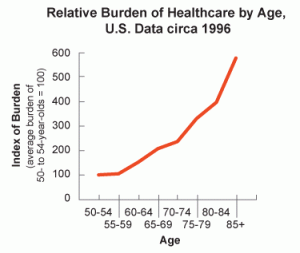 The majority of Americans generally like the idea of remote home monitoring for health. 3 in 5 adults (62%) across all age groups say communication with doctors via home monitoring devices would improve their health. However, only 35% of people age 65 and over are interested in home health monitoring. Interest in remote home health monitoring decreases with age.
The majority of Americans generally like the idea of remote home monitoring for health. 3 in 5 adults (62%) across all age groups say communication with doctors via home monitoring devices would improve their health. However, only 35% of people age 65 and over are interested in home health monitoring. Interest in remote home health monitoring decreases with age.
The disconnect is that 90% of Americans age 65 and older have at least one chronic health condition, according to the Centers for Disease Control.
Practice Fusion commissioned a survey from GfK Roper in November 2010 through the GfK Omnibus survey among 1,008 adults age 18 or older. Margin of error is plus or minus three percentage points.
 Health Populi’s Hot Points: As people age, the incidence of chronic conditions increases. Furthermore, the costs of health care grow exponentially with age, as the chart clearly illustrates.
Health Populi’s Hot Points: As people age, the incidence of chronic conditions increases. Furthermore, the costs of health care grow exponentially with age, as the chart clearly illustrates.
The evidence base supporting the adoption of remote health monitoring is growing, health condition by health condition, population segment by population segment. Older people managing chronic disease have the most to gain from using remote health monitoring applications in terms of healthy aging at home — thus delaying or replacing eventual care in a long-term care institution. This then yields financial cost savings, by keeping people well, longer, at home and out of more expensive institutional settings as well as hospitals for re-admissions in cases of chronic heart failure, for example.
The disconnect shown in Practice Fusion’s survey illustrates one of the key barriers to connecting health and getting to participatory medicine in America. Until consumers, especially older, sicker ones, understand and ‘see’ the logic behind remote health monitoring, there will be a gap between consumer demand and willingness to adopt these applications versus the promise of what these technologies can deliver. The role of usability and design for remote health monitoring cannot be underestimated: ethnographers, sociologists, and psychologists all have roles to play here, along with consumer product designers and consumer-users themselves.
Finally, physicians and clinical staff connected at the other end of the monitoring must be engaged. Practice Fusion is an EHR vendor interested in engaging physicians with their products. Remote health monitoring data, which can populate the EHR and consumers’ personal health record, can add value to the physician’s record by complementing the data set that’s written into the record during the in-person visits throughout the year. These real-time, real-life stats that track peoples’ health help the physician and patient work together to optimally manage chronic health. But the physician adoption barriers are many, including how to incorporate remote health monitoring into the daily practice workflow, liability issues, and the granddaddy of them all, reimbursement and payment. The pay-for-performance paradigm as well as medical home models could motivate physician adoption of remote monitoring.




 Thank you, Trey Rawles of @Optum, for including me on
Thank you, Trey Rawles of @Optum, for including me on  I was invited to be a Judge for the upcoming
I was invited to be a Judge for the upcoming  For the past 15 years,
For the past 15 years,